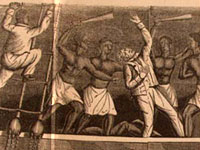Exploring Amistad: Race and the Boundaries of Freedom in Maritime Antebellum America

Presents more than 500 primary documents relating to the 18391842 revolt of enslaved Africans aboard the schooner Amistad, their legal struggles in the United States, and the multifaceted cultural and social dimensions of the case. The site features a searchable library that contains 32 items from personal papers, 33 legal decisions and arguments, and 18 selections from the popular media, including pamphlets, journal articles, reports, a playbill, and a poem.
In addition, 100 government publications, 28 images, 11 maps and nautical charts, and 310 newspaper articles and editorials are available. The website provides suggestions for using these materials in the classroom, a timeline, links to other resources, and a "living the history" component that encourages user feedback and participation. This visually attractive, well-conceived site provides a wealth of materials for students of slavery, race, politics, and print culture in antebellum America.